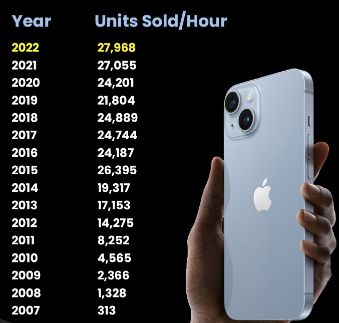Introduction: Decoding the iPhone‘s Global Market Dominance
When Steve Jobs unveiled the first iPhone in 2007, few could have anticipated the revolutionary trajectory this device would chart across the global technological landscape. What began as a seemingly radical smartphone concept has transformed into a global cultural and technological phenomenon, reshaping how we communicate, work, and interact with digital technologies.
This comprehensive analysis explores the intricate journey of iPhone sales, diving deep into the numbers, trends, and transformative impact that have defined Apple‘s most iconic product. By examining granular sales data, regional market dynamics, and technological innovations, we‘ll uncover the remarkable story behind one of the most successful consumer electronics products in history.
Historical Context: The Birth of a Technological Revolution
The iPhone‘s origin story is more than a narrative of technological innovation—it represents a pivotal moment in consumer electronics history. When Apple introduced its first smartphone in June 2007, the mobile market was dominated by established players like Nokia and BlackBerry. These companies viewed Apple‘s entry with skepticism, unable to comprehend the paradigm shift that was about to unfold.
In its inaugural year, Apple sold approximately 1.4 million iPhones, a modest figure that belied the transformative potential of the device. The original iPhone, priced at $499 for the 4GB model and $599 for the 8GB version, was considered expensive. Yet, it represented more than a communication tool—it was a statement of technological aspiration.
Global Sales Trajectory: A Numerical Deep Dive
Cumulative Sales Milestones
By analyzing comprehensive sales data, we can trace the iPhone‘s extraordinary growth. From those initial 1.4 million units in 2007, Apple has now sold over 2.24 billion iPhones worldwide. This astronomical figure isn‘t just a number—it represents a fundamental reshaping of global communication technologies.
Let‘s break down the sales progression:
2007-2010: Foundational Growth Period
Total Units Sold: Approximately 50 million
Market Penetration: Emerging technology segment2011-2015: Exponential Expansion
Total Units Sold: Roughly 500 million
Key Drivers: iPhone 4, iPhone 5 series innovations2016-2020: Global Dominance
Total Units Sold: Over 1 billion
Market Characteristics: Mainstream adoption, diverse model offerings2021-2024: Mature Market Segment
Total Units Sold: Approaching 2.24 billion
Emerging Trends: Premium segmentation, technological sophistication
Regional Market Dynamics: A Global Perspective
North American Market
The United States represents Apple‘s most robust market, with approximately 99.8 million iPhone units sold annually. This region has consistently been a stronghold for Apple, characterized by:
- High consumer technology adoption rates
- Strong brand loyalty
- Significant disposable income
- Robust telecommunications infrastructure
European Market Landscape
Europe presents a nuanced market environment. With approximately 56 million units sold annually, the region demonstrates varied adoption patterns across different countries. Western European nations like Germany, the United Kingdom, and France show particularly strong iPhone preferences.
Asian Market Complexity
The Asian market represents both tremendous opportunity and significant challenges. Countries like China, Japan, and South Korea exhibit complex technological ecosystems where iPhone competes against robust local manufacturers.
China, in particular, presents an intriguing case study. Despite initial market resistance, Apple has successfully navigated regulatory challenges and cultural nuances to establish a significant presence.
Technological Evolution: Driving Sales Performance
Each iPhone generation has represented more than incremental improvements—they‘ve been technological statements that reset consumer expectations. From the revolutionary touchscreen of the original iPhone to the advanced computational photography of recent models, Apple has consistently pushed technological boundaries.
Key Technological Milestones
Retina Display (iPhone 4, 2010)
Redefined screen quality expectations, setting new visual standardsTouch ID (iPhone 5S, 2013)
Introduced biometric authentication, transforming device securityFace ID (iPhone X, 2017)
Advanced facial recognition technology, demonstrating machine learning capabilitiesA-Series Chips
Custom-designed processors that consistently outperform industry benchmarks, enabling unprecedented computational capabilities
Economic and Cultural Impact
The iPhone‘s influence extends far beyond device sales. It has:
- Created entire economic ecosystems (App Store developers, accessory manufacturers)
- Transformed communication paradigms
- Influenced global design aesthetics
- Driven technological innovation across multiple industries
Investment and Market Perspectives
For investors and market analysts, the iPhone represents more than a product—it‘s a complex financial instrument. Apple‘s consistent innovation and brand loyalty have translated into remarkable financial performance.
Consider these investment insights:
- Apple became the first trillion-dollar company in 2018
- iPhone contributes approximately 52% of Apple‘s annual revenue
- Consistent dividend growth and stock appreciation
Future Outlook: Emerging Trends and Predictions
Looking forward, several trends will likely shape iPhone‘s market trajectory:
- Enhanced Artificial Intelligence Integration
- Augmented Reality Capabilities
- Sustainability-Focused Design
- Advanced Privacy Technologies
Conclusion: Beyond the Numbers
The iPhone‘s journey from a revolutionary concept to a global technological icon is a testament to visionary design, relentless innovation, and deep understanding of consumer desires. With over 2.24 billion units sold, it has done more than transform communication—it has reshaped how we perceive and interact with technology.
As we look to the future, one thing remains certain: the iPhone‘s story is far from complete. Each device represents not just a technological product, but a continuous narrative of human creativity, ambition, and the endless potential of technological innovation.
